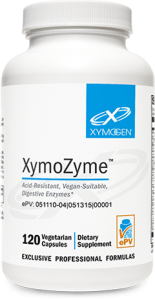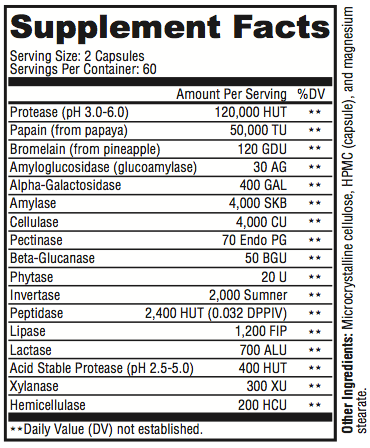XymoZyme

Pancreatic and Intestinal Enzymes Pancreatic production of proteases, amylases, and lipases is complemented by intestinal production of lactase, maltase, sucrase, enterokinase, and various peptidases, highlighting the importance of the pancreas and the intestines in the digestive process. The enzyme lactase is required to break down lactose into glucose and galactose before the intact lactose can draw excess water into the bowel, and before colonic bacteria can break it down into volatile gases and acids. Though lactose (a disaccharide found only in mammals’ milk) is readily digested by most infants, normal production decreases as a child is weaned onto whole foods and may eventually cease in adulthood. Exogenous administration of lactase can support lactose digestion effectively and allow for continued consumption of milk- based products.[3,4] Maintaining a healthy gastrointestinal flora helps support brush border function and digestive capacity as well.*[5]
Digestion of Plant-Based Compounds XymoZyme contains several principle digestive enzymes as well as a complement of enzymes designed to break down plant compounds and fibers that humans would otherwise be unable to digest. Raffinose and melibiose, carbohydrates commonly found in legumes, can be broken down by the intestinal enzyme alpha-galactosidase. In the absence of this enzyme, these carbohydrates pass into the large intestine, where microbes can ferment them and produce volatile gases. Exogenous administration of alpha-galactosidase, present in PrimeNZyme, supports the digestion of these plant-based compounds and has been used safely and effectively.[6,7] Beta-glucanase, hemicellulase, pectinase, xylanase, and dipeptidyl peptidase (DPPIV) are also present and improve the digestibility of plant-based foods by breaking down plant cell walls, fibers, and proteins. Phytase is present to facilitate the breakdown of indigestible phytates from grains and seeds, and release phosphorus, calcium, inositol, and other nutrients for absorption. Bromelain and papain offer additional support for protein digestion. The enzyme invertase catalyzes sugar to glucose and fructose.*
XymoZyme incorporates amylase, lipase, proteases, hemicellulase, bromelain, papain, lactase, DPPIV, and other key digestive enzymes to provide a comprehensive formulation that functions in a wide pH range to support and facilitate healthy digestion. It has been formulated to allow flexible dosing that can be adjusted for individual needs.*
Directions
Take 1-2 capsules with each meal or snack. If necessary, capsules may be opened and contents sprinkled over food.
References
- Bland J, Liska D, Jones DS, et al. Clinical Nutrition A Functional Approach. 2nd ed. Gig Harbor, WA: The Institute for Functional Medicine. 2004.
- Whitcomb DC, Lowe ME. Human pancreatic digestive enzymes. Dig Dis Sci. 2007 Jan;52(1):1-17. Review. [PMID: 17205399]
- Sanders SW, Tolman KG, Reitberg DP. Effect of a single dose of lactase on symptoms and expired hydrogen after lactose challenge in lactose-intolerant subjects. Clin Pharm. 1992 Jun;11(6):533-8. [PMID: 1534729]
- Heyman MB; Committee on Nutrition. Lactose intolerance in infants, children, and adolescents. Pediatrics. 2006 Sep;118(3):1279-86. Review. [PMID: 16951027]
- Zaouche A, Loukil C, De Lagausie P, et al. Effects of oral Saccharomyces boulardii on bacterial overgrowth, translocation, and intestinal adaptation after small-bowel resection in rats. Scand J Gastroenterol. 2000 Feb;35(2):160-5. [PMID: 10720113]
- Di Stefano M, Miceli E, Gotti S, et al. The effect of oral alpha-galactosidase on intestinal gas production and gas-related symptoms. Dig Dis Sci. 2007 Jan;52(1):78-83. [PMID: 17151807]
- Ganiats TG, Norcross WA, Halverson AL, et al. Does Beano prevent gas? A double-blind crossover study of oral alpha-galactosidase to treat dietary oligosaccharide intolerance. J Fam Pract. 1994 Nov;39(5):441-5. [PMID: 7964541]
These supplements are available at our Tulsa, Oklahoma Health & Wellness Clinic.








